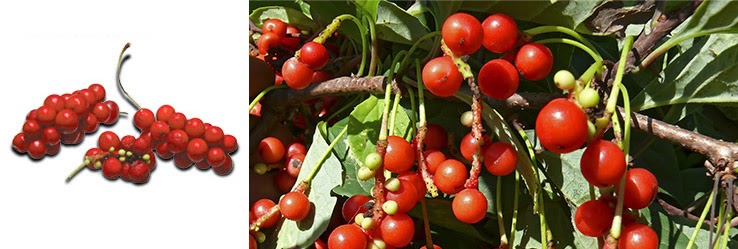
SCHIZANDRA
Schisandra chinensis
Schisandra chinensis
Parts used: fruits.
Authorized health claims:
- Adaptogenic tonic.
- Antioxidant.
- Liver function.
- Functionality of the upper respiratory tract.
PROPERTIES
- Male tonic (continued use increases vigour and sexual potency);
- Adaptogen, helps the body adapt to stress (similar to ginseng and eutherococcus);
- Sexual tonic (for men and women);
- Nerve tonic;
- Kidney tonic;
- Lung tonic;
- Cardiotonic;
- Stimulant (improves body power and strength);
- Hepatoprotective (against free radicals, boosts liver regeneration, protects the liver from toxins and diseases);
- Lung astringent;
- Sedative (although stimulant!);
- Anticonvulsant;
- Calming;
- Anti-fatigue;
- Antidepressant;
- Cardiostimulant;
- Vasodilator;
- Normalizes blood pressure;
- Uterine stimulant;
- Immunomodulatory (strengthens the immune system);
- Antioxidant;
- Helps improve the complexion and therefore the appearance and beauty of the skin;
- Regulates the secretion of body fluids;
- Controls cough;
- Moistening (wetting dry and irritated tissues);
- Psychological and emotional remedy;
- Improves concentration;
- Anti-inflammatory;
- Antitumoral;
- Anthelmintic.
INDICATIONS:
- Decreased energy;
- Involuntary ejaculation;
- Impotence;
- Physical exhaustion;
- Urinary disorders;
- Excessive diuresis (excessive urination frequency);
- Circulatory failure;
- Dry cough;
- Shortness of breath;
- Asthma;
- Insomnia;
- Restless sleep;
- Neurasthenia;
- Chronic (and early morning) diarrhea;
- Dysentery;
- Night and spontaneous sweats;
- Tuberculosis;
- Viral hepatitis (higher than silymarin);
- Chronic hepatitis;
- Metabolic diseases;
- Dehydration
- Thirst;
- Diabetes;
- Weak memory;
- Hyperacidity;
- Palpitations;
- Mental illnesses;
- Nerve diseases;
- Irritability;
- Skin problems;
- Hives;
- Eczema;
- Clammy skin;
- Dry skin;
- Irritated skin;
- Loss of vision;
- Hearing Loss;
- Chronic cough;
- Chronic asthma;
- HIV infection.
To facilitate the sheet reading, the main properties are highlighted in
bold. The indications on the traditional use of plants in the herbal sector,
have been derived from the following literature sources, which should be
consulted for in-depth information on plants and other interesting uses and
suggestions:
- PDR (Physicians’ Desk Reference) for Herbal Medicines, Fourth Edition, Ed. Thomson 2007.
- Perugini Billi F., Manuale di Fitoterapia, Edizioni Junior, Azzano San Paolo (BG) 2004.
- Tierra M., Grande manuale di Erboristeria, Vol. I e II, Mediterranee, 1995.